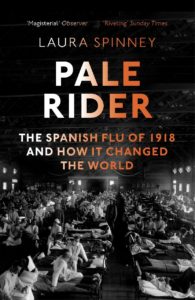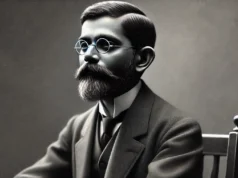
Laura Spinney, Pale Rider: The Spanish Flu of 1918 and how it changed the World. Penguin Random House, 2018, 352 Pages.
The Spanish Flu (1918) was nothing but a “great tidal wave of death.” It infected a third of the global population. With 50–100 million people dead, it surpassed the First World War (17 million dead) and the Second World War (60 million people) and possibly the two put together.
So, was 1918 the year the War ended or was it the year of the Flu? As a science journalist and a literary novelist, Laura Spinney addresses this question in her book, Pale Rider: The Spanish Flu of 1918 and how it changed the World.
Interestingly, Spinney takes a starkly different approach to tell the story of the Flu. Most previous accounts of the Spanish Flu overly focus on either Europe or America. But Spinney’s book chooses to shine a light on areas of the map that were previously dark.
The neglect of the Global South
Firstly, Spinney captures the global reach of the disaster. Drawing from academically and geographically diverse information available today, she indicates how the Spanish Flu was experienced in other parts of the World.
The dominant European and North American-centric accounts have distorted our understanding of the effect of the Spanish Flu around the World. Actually, France, Britain, Germany, and Italy lost more people to the War than the Flu.
The Flu killed more people in South America, the Middle East, Russia, India, South East Asia, and inland China than in Europe and America. Thankfully, we know a lot about the Pandemic now than ever before.
The Big Picture
Secondly, Spinney delineates the story of the Spanish Flu (Parts Two to Six) – how it emerged, swept the planet, and receded, leaving humanity transformed – in exquisite detail.
But more importantly, Spinney moves from the planet to the human and prehistory to 1918. She brilliantly narrates how man and Flu have cohabited and co-evolved for almost 12,000 years (Part 1). Further, she explores the traces of the Spanish Flu with which we live today (Part 7)
The Pandemic as a Social Phenomenon
Thirdly, Spinney reminds us that the Pandemic is a social phenomenon and not merely biological. The Pandemic, Spinney argues, cannot be separated from its historical, geographical, and cultural context.
Every Pandemic is an encounter between a disease-causing microorganism and a human being. However, the encounter is shaped by numerous other events taking place simultaneously.
The question of memory.
Fourthly, Spinney addresses the question of memory through the question, “Why the Spanish Flu is forgotten?” and this despite its profound impact. The Spanish Flu influenced the course of the First World War and, arguably, contributed to the Second. Further, it accelerated the pace of change in the first half of the twentieth century and helped shape our modern World.
Spinney rightly concludes: “1918 was the year of the Flu, not the year the War ended”. Anticipating the centenary of the 1918 Pandemic, she hopes that historians will fill in more of the blanks and that the light shed by science will be brighter.
The Spanish Flu was a shared experience of grief, suffering, and loss. It changed our World forever. There is a sense in which history repeats itself. Spinney’s book helps us see the Pandemic as a social phenomenon. It will do us good to remember this as we face the COVID-19 Pandemic.
Samuel Thambusamy is a PhD candidate with the Oxford Center for Religion and Public Life.
Read Other Reviews by Samuel Thambusamy
Doing Political Theology – the Pentecostal Way









